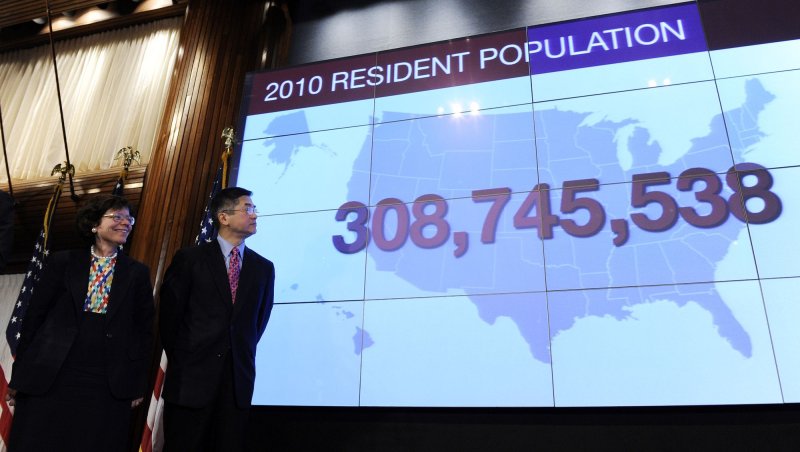1 of 3 | Commerce Secretary Gary Locke and acting Deputy Commerce Secretary Rebecca Blank look at a US map showing the official population of America as 308,745,538 persons during a news conference to release the first set of 2010 census data in Washington on December 21, 2010. UPI/Roger L. Wollenberg |
License Photo
WASHINGTON, Dec. 21 (UPI) -- The U.S. population as of April 1 was 308,745,538 people, a 9.76 percent growth over the 2000 population, Census Bureau Director Robert Groves said Tuesday.
Among other things, the census declares the number of seats each state has in the 435-member House of Representatives and is linked to state redistricting to ensure congressional districts are roughly equal in population. The census also helps determine how federal funding is distributed.
The changes in population means a shift of 12 House seats affecting 18 states, Groves said during a news conference. States gaining seats include Arizona, Florida, Georgia, Nevada, South Carolina, Texas, Utah and Washington. Losing seats will be Illinois, Iowa, Louisiana, Massachusetts, Michigan, Missouri, New Jersey, New York, Ohio and Pennsylvania.
Thirty-two states experienced no change in House representation, Groves said.
With four, Texas gained most seats, Groves said. It marks the seventh consecutive census in which Texas saw a gain in congressional representation, he said.
California will have 53 House seats, followed by Texas with 36 seats, and New York and Florida tied at 27 seats, Groves said. Seven states have one representatives.
The average population size for congressional district is 710,767 people, up from 646,952 people in 2000, Groves said.
Starting in February, the Census Bureau will begin releasing to states information that can be used in redistricting, he said.
The most populous state was California, with 37,253,956 people and Wyoming was the least populous, with 563,626 people. Regionally, the South and the West picked up most of the population increase, 14,318,924 and 8,747,621 people. The Northeast and the Midwest reported smaller gains of 1,722,862 and 2,534,225.
Commerce Secretary Gary Locke, in whose department the Census Bureau resides, called Tuesday "a really important day for the American people."
He said the census came in on time and was $1.87 billion under budget. Its operating budget was about $7 billion.
He thanked Americans for either mailing in the 10-question form or responding to census-takers when they followed up to take the information in person.
"All of you helped to paint this latest portrait of America," Locke said.















